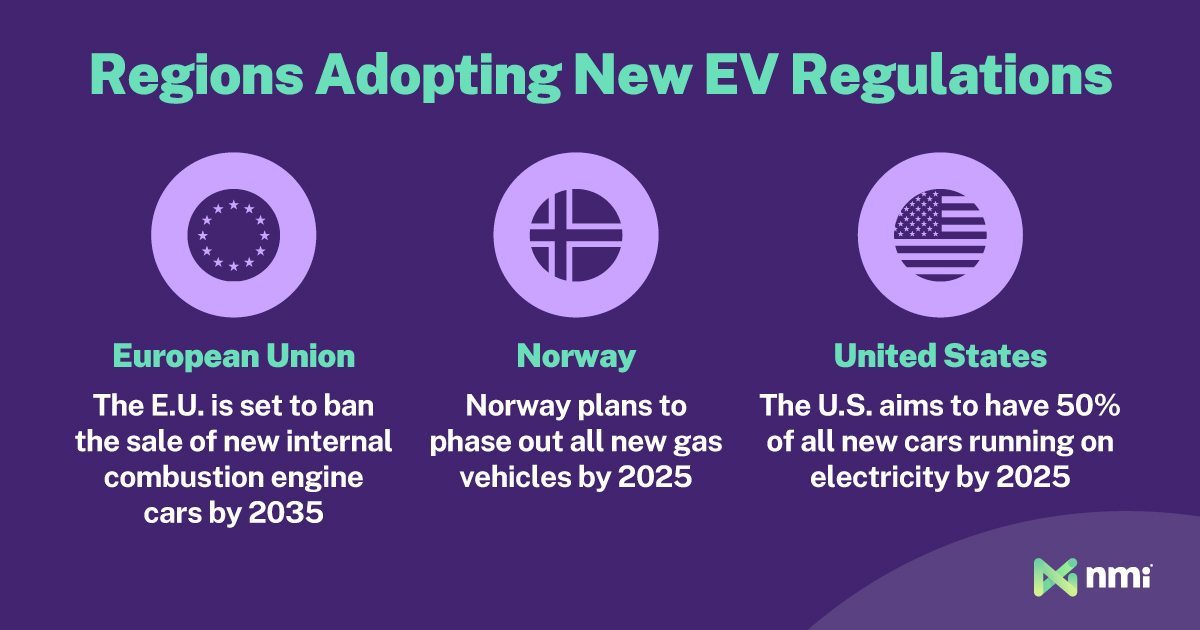Electric vehicles (EVs) are the future of transportation. Once a novelty, most prominent car companies are now manufacturing EVs, including BMW, Audi, Cadillac and others. Nearly 40% of consumers are considering purchasing one, especially 18- to 49-year-olds, the most important demographic for future car sales.
Worldwide, countries are making infrastructure plans for the eventual dominance of EVs, including more public fast charging stations with unattended payment options.
Fast charger payments will present an excellent opportunity for EV infrastructure providers and their payment partners in the coming years. Those who are successful will tap into a market that could generate over $22 billion in payment volume by 2030. However, to stand out in this growing market, businesses will have to make paying for EV charging fast, frictionless and convenient.
An Increasingly Important Payments Opportunity
Dozens of countries are currently phasing out vehicles with internal combustion engines (ICE). The European Union — among the leading adopters of EVs — is set to ban the sale of new ICE cars by 2035. Norway plans to phase out all new gas vehicles by 2025. Although the United States has historically lagged behind Europe, it aims to have 50% of all new cars running on electricity by 2025.
EV dominance is coming fast, leading to heightened demand for charging stations. In 2022, the U.S. installed 6,300 new fast chargers — a 30% increase year over year. The EU saw a 55% increase, raising its total to 70,000 fast chargers. These numbers are a drop in the bucket compared to what’s coming.
The United States alone needs approximately 28 million public fast chargers to meet demand by 2030. Public fast chargers are slowly replacing traditional fuel stations, and they require self-serve payment capabilities, making the EV takeover an enormous emerging opportunity for the payments industry.
The Need for Frictionless EV Payments
Although they’re becoming more common, EV charging stations are less available than traditional gas stations. You can find them in the parking lots of big box stores and shopping centers, at community centers and rest stops, along streets, and in dozens of other locations. However, EV chargers are sparse, with most being fully unattended.
The dispersed, unattended nature of EV chargers makes it crucial for drivers to have the ability to pay quickly, easily and with whatever electronic payment method they find most convenient.
For instance, consider an EV driver on a cross-country trip. They’re running low on energy and stop at a charging station to refuel. Unfortunately, the station only processes transactions through its app, and the internet signal is too weak for the driver to download and create an account. At best, they can’t pay, leave frustrated and find somewhere else to charge. At worst, they find themselves stranded — an enormously negative experience.
EVs are still new, and many people don’t have much experience charging them or paying at fast chargers. That means the user interface has to be straightforward, intuitive and convenient. A big part of this is letting people pay how they want, whether tapping a credit card, using a digital wallet or paying with an app like Venmo. The more convenient we can make paying, the better it’ll be for the end user and adoption.

Embedded Payments vs. Branded Applications
Today, two solutions are competing for dominance in EV charging — embedded payments built directly into an EV charging station and app-based payments that users download to their devices. Each offers benefits and drawbacks, and they both have the potential to survive in the market long-term.
EV Charging Applications
The upside of apps is that they do more than just take payments. Charging infrastructure isn’t as accessible as fueling infrastructure (yet), so EV drivers often plan more than ICE drivers, especially for longer trips. Apps like PlugShare and ChargePoint make finding chargers easy, enabling drivers to sort and filter charging stations along their routes, plan trips and more. In these cases, paying for a charge directly through an app offers a more complete experience.
However, there are two downsides to app-only EV charging:
- A lack of internet access
- The prominence of proprietary apps
Drivers in big cities don’t have to worry about poor connectivity. However, weak cellular service can quickly become a problem on long-distance or countryside trips. If a driver has to pay for charging with an app that can’t connect to the internet, they could find themselves stranded.
Another issue is the prominence of proprietary apps that silo drivers into specific networks. Think of it as trying to order an Uber through the Lyft app, but now you have thirty ride-share apps to sort through whenever you want to go somewhere new.
Siloing and accessibility issues encouraged the United Kingdom to enact legislation in 2023 requiring all eight kW or higher fast chargers to have embedded contactless payments. This ensures drivers can quickly and easily pay for charging, even if they don’t have an app installed or internet service.
Embedded EV Payments
Embedded payments build the payment experience directly into the charger’s software and user interface. At its most basic, this would include standard Europay, Mastercard and Visa (EMV) tap payments with debit or credit cards. Providers can also embed digital wallets, Radio Frequency Identification (RFID) payment tags and scannable QR codes into charging stations.
Offering non-brand-specific payment methods ensures drivers can charge when and where they need to without worrying about specific networks. Embedded EV payments also closely mimic how drivers pay for gas, helping ease the transition from gas to electric.
Enabling the Future of EV Payments
As EVs and fast chargers become more common, payment companies will need to enable the widest range of frictionless, unattended payment options possible.
The future will likely include both embedded in-charger solutions and mobile applications. Payment providers targeting EVs should be ready to serve both; the key to competing in the space is ensuring fast-charging providers can access everything they need from a single vendor.
Another unique opportunity will be serving hardware and software manufacturers who want to monetize payments. Today, companies manufacturing EV chargers — and unattended payment kiosks — largely become payment facilitators or independent sales organizations to monetize their payment systems.
However, in the future, revenue share partnerships with all-in-one platforms, like NMI, could become the norm. This type of partnership would provide manufacturers with the benefits of monetized payments without the complexity or compliance burden.
To learn more about how NMI enables unattended commerce, including frictionless EV charging payments, reach out to a member of our team or read my interview in EV Magazine.
Don’t just turn on payments, transform the way you do business
- Generate New Revenue By adding or expanding payment offerings to your solution, you can start earning higher monthly and transaction-based recurring revenue.
- Offer the Power of Choice Allow merchants to choose from 125+ shopping cart integrations and 200+ processor options to streamline their onboarding.
- Seamless White Labeling Make the platform an extension of your brand by adding your logo, colors and customizing your URL.






